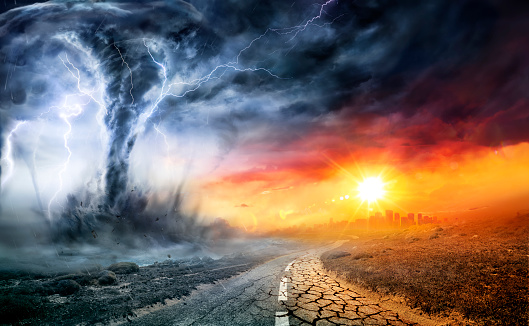CLIMATE CHAOS IN 2021
Global warming and GHG emissions resumed their upward march, after a short lived drop in 2020 due to the pandemic.
2021 was the sixth-hottest year on record. The average global temperature in 2021 was about 1.11°C above the pre-industrial (1850-1900) levels.
As for GHG, they rose by 6% in 2021 to 36.3 billion tonnes, their highest ever level, as the world economy rebounded strongly from the Covid-19 crisis and relied heavily on coal to power that growth, according to new IEA analysis released in March 2022. Nonetheless, the more advanced economies did show modest declines, while coal dependent India and China rebounded sharply. In fact, coal is the fossil fuel that is responsible for the largest share (40%) of GHG emissions.
HEAT WAVES AND DROUGHTS
In the last four years, Europe has experienced extreme temperatures rising from year to year. According to the Copernicus Climate Change Service (C3S), "Overall, June–July–August 2021 ranks as the warmest (ever recorded) European summer."
In summer 2021, much of Western North America suffered an extreme heat wave. Attribution analysis found that this was a 1000-year weather event, made 150 times more likely by climate change.
This severe heat translated into deadly droughts. According to the EDF, "drought conditions have been ongoing since early summer 2020 – and have persisted, worsened, and expanded dramatically – across vast portions of the continental U.S". CNN put the great North Western drought at the top of its list of The Seven most devastating climate disasters of summer 2021.
This is unlikely to be an isolated event. The environmental NGO EDF notes that “scientists predict that increases in evaporation will outpace increases in precipitation, leading to more frequent and extensive dry periods….The excess heat trapped in the climate system draws out more moisture from soils, thereby worsening drought conditions. Reduced snowpack volumes, earlier snowmelt, and changing precipitation patterns – also linked to climate change – exacerbate the water stress induced by droughts”, setting the stage for the raging wildfires of 2021 in Northwestern America and around the Mediterranean Basin.
WILDFIRES AROUND THE WORLD
Earth is an intrinsically flammable planet owing to its cover of carbon-rich vegetation, seasonally dry climates, atmospheric oxygen, and widespread lightning and volcanic ignitions.
Consider two examples from 2021: the state of California and the Mediterranean Basin.
In 2021 a series of wildfires raged across California. By the end of 2021 a total of 8,835 fires were recorded, burning 2,568,948 acres (1,039,616 ha) across the state….The wildfire season in California experienced an unusually early start amid an ongoing drought and historically low rainfall and reservoir levels. The long term trend is that wildfires in the state are increasing due to climate change in California
Based on data from the European Forest Fire Information System (EFFIS), 2021 was the second-worst wildfire season in the EU since 2000, when the EFFIS records began. The EFFIS report finds that large and extreme fires affected many countries, especially in the Mediterranean Basin and warns about the dangerous conditions that fuel wildfires. In 2021, fires were observed in 39 countries, burning over a million hectares.
Just before his return from a six month stay on the International Space Station, French astronaut Thomas Pesquet in a video call described these giant wildfires seen from space:"Entire regions were burning, Canada and California covered with clouds of smoke and flames that you could see with the naked eye at an altitude of 400 kilometers....and the same thing in the south of France, Greece and all around the Mediterranean basin."
One final note: over the past century, wildfires have accounted for 20-25% of global carbon emissions, the remainder from human activities. Global carbon emissions from wildfires through August 2020 equaled the average annual emissions of the EU. In a vicious circle, the intensifying wildfires we have seen around the world for many years now are not just a consequence but also a contributor to global warming.
DEADLY FLOODING IN EUROPE
The record-shattering rainfall that caused deadly flooding across Germany and Belgium in July 2021 - killing at least 222 people and causing huge damage - was made up to nine times more likely by the climate crisis, according to a study by Prof Maarten van Aalst (University of Twente) and 38 other scientists.
Belgian Minister of Home Affairs Annelies Verlinden described the events as "one of the greatest natural disasters our country has ever known." German minister-president Malu Dreyer of the Rhineland-Palatinate called the floods "devastating". In addition to fatalities, they led to widespread power outages, forced evacuations and severe damage to infrastructure and agriculture.
Disastrous flooding from thunderstorms also hit many other countries. In October, in one night up to two meters of rain fell on the Marseille area in South-East France, causing torrential floods and widespread destruction. In the US, in August, a staggering amount of rain – a third of the region’s annual rainfall- led to flash flooding in Tennessee.
According to a CNN meteorological analysis “Extreme rainfall events are likely to become more common, too, as long as the planet continues to get hotter (due to) the Clausius-Clapeyron principle in physics. Warmer air can hold more water vapor -- about 7% more water vapor per 1 degree Celsius. More water vapor in the atmosphere means more moisture available to fall as rain, which leads to higher rainfall rates.”
According to The Guardian of August 23, 2021, "Other research in July found that catastrophic floods in Europe could become much more frequent as a result of global heating....In addition, slow-moving storms could become 14 times more common over land by the end of the century in a worst-case scenario. The slower a storm moves, the more rain it dumps on a small area and the greater the risk of serious flooding."
TORNADOES ON THE RAMPAGE IN THE UNITED STATES
December, a month known for cold weather and snow, was instead marked in 2021 by a barrage of tornadoes produced by extreme thunderstorms. No December on record has seen as many tornadoes or such a devastating toll on life and businesses. Few areas of the central United States were untouched by severe storms, as the strong winter jet stream spread over temperatures more typical of spring.
“In my 40 years as a meteorologist, this was one of the most shocking weather events I've ever witnessed,” says Jeff Masters, a meteorologist at Yale Climate Connections. “Watching these storms on Friday night, my thought was, ‘Is no season safe?’ Extreme tornadoes in December?” Meteorology professor Victor Gensini said: “It was really a late spring type of setup in the middle of December.”
According to the NOAA, the tornadoes that ripped across the central and southern U.S. on December 10, 2021, were notable in many ways. The thunderstorms and 70 tornadoes they produced traveled far — sometimes far more than 160 km — and impacts were widespread. Eight states reported tornadoes that killed more than 80 people and brought devastating damage. This tornado outbreak, according to Kentucky Gov. Andy Beshear, wreaked a level of devastation "unlike anything I have ever seen."
On December 15, tornadoes struck the Midwest. Although the mid-month tornadoes were not as intense as the outbreak a few days prior, this event produced one of the largest single-day tornado outbreaks in recorded history. Overall, there were 222 tornadoes, by far the most active December for tornadoes on record.
The attribution of these outbreaks to global warming is not totally proven. Still, scientists say that the conditions that give rise to such outbreaks are intensifying each winter as the planet warms. Extreme storms, Gensini says, are “becoming more common because we have warmer air masses in the cool season that can support these severe weather outbreaks.”
TROPICAL CYCLONES: ATLANTIC HURRICANES
The disastrous flooding in Europe in 2021 was the result of severe thunderstorms, which are produced by cumulonimbus clouds (“thunderheads”) that include rain showers, lightning, thunder and sometimes tornados. Thunderstorms can last from several minutes to more than an hour.
A tropical cyclone is an entirely different phenomenon: massive, spinning formations of multiple thunderstorms. In fact, the word cyclone comes from the Greek kyklôn, meaning “revolving.” Compared to thunderstorms, tropical cyclones are much larger, ranging from 160 to 1450 kilometers in diameter, and last much longer: from several hours to three weeks. Atlantic hurricanes are one sort of tropical cyclone. In the Pacific, they are just called cyclones.
The 2021 Atlantic hurricane season was the third-most active on record and will likely go down as one of the most expensive. Hurricane Ida alone – which ranks second in the CNN list of devastating 2021 summer natural disasters - caused more than $60 billion in damages.
Scientists say that climate change is making hurricanes more dangerous, for three reasons:
· Hurricanes are getting stronger and intensifying faster
Hurricanes are being made more intense faster by the warming ocean, which absorbs about 90% of the planet's excess heat due to GHG emissions. As the planet heats up, storms get stronger. Faster intensification also makes predicting their paths for emergency readiness more difficult.uy
Climate change helped Ida intensify before landfall. In 24 hours, it jumped from a Category 1 to a Category 4 storm as it moved over abnormally hot water in the Gulf of Mexico.
· Hurricanes are wetter and moving slower
Satellite data also shows that storms are getting slower, particularly after they make landfall, according to Katherine Hayhoe, chief scientist at Nature Conservancy. Slower and larger storms cover a greater area and dump more rain.
While research is still developing, a 2020 study in the journal Nature found storms are staying stronger farther inland. Ida hit land in Louisiana, forged 1640 km of destruction across the central US and produced catastrophic flooding in the Mid-Atlantic States including New York.
· Storm surge is getting higher
Storm surge - when hurricane winds push ocean water over land - is also getting worse due to sea level rise. Hayhoe said storm surge can inundate a larger area now than it would from a similar hurricane about 50 or 100 years ago. As the water piles up along the coast, rivers can be blocked, forcing water levels to rise upstream.
Tom Knutson, of the NOAAA, said storm surge is "one of the more dangerous aspects of hurricanes." Nearly half of all deaths from tropical cyclones come from storm surge.
As the ocean gets warmer due to fossil fuel emissions, the world is will likely experience more hurricanes that are as severe as Ida. The choice, said Hayhoe, is to either rapidly cut GHG emissions or face the catastrophic impacts of the climate crisis….unless of course it’s already too late.



Comments
Post a Comment